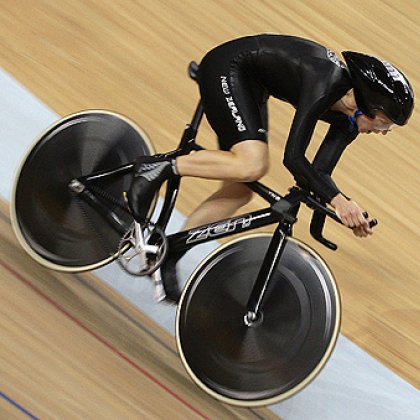
Using ultrasound imaging, UQ physiotherapist Dr Julie Hides is helping a world-champion cyclist ride her bike pain free.
New Zealand cyclist Alison Shanks, who was assessed by Dr Hides at the UQ/Mater Back Stability Clinic last month, is now following a new exercise regime.
“Ali actually experiences pain down one side of her leg and in her hip when she cycles,” Dr Hides said.
“The demands of different sports often create muscle imbalances and ultrasound imaging allows us to see what the deeper muscles are doing.
“We can then design an individual exercise program that addresses those muscle imbalances.”
A member of New Zealand’s 2008 Beijing Olympic team, Ms Shanks was recently crowned World Champion of the 3000-metre individual pursuit.
She won the title at the World Championships held in Poland in March, completing the velodrome event in a personal best time of 3 min, 29.8 sec.
Dr Hides met Ms Shanks in her hometown of Dunedin while visiting colleague Helen Littleworth, a physiotherapist for the New Zealand Olympic team.
“We did an MRI of Ali’s back and hip muscles to identify some muscle imbalances,” Dr Hides said.
“We also looked at size and between side symmetry of muscles and her motor control (ability to voluntarily contract) her back, abdominal and hip muscles.
“We assessed her at the Mater Back stability clinic where we set her up on her bike on the wind trainer and looked at the dynamic control of her muscles using ultrasound imaging while cycling.
“We are using ultrasound imaging to provide feedback of the patterns of correct activation of her back, abdominal and hip muscles.”
Dr Hides became involved with the New Zealand Olympic physiotherapy team just prior to the Beijing games, after being contacted by Ms Littleworth about her research on ultrasound imaging.
The pair worked successfully together on one of the Olympic athletes and have continued to collaborate in achieving the best outcome for Ms Shanks.
Using ultrasound imaging for assessment and rehabilitation was a method developed at UQ and has been successfully trialed with cricketers attending the Cricket Australia Centre of Excellence and elite AFL players.
Dr Hides, whose specialty is back pain as opposed to sports physiotherapy, said working with athletes had exposed her to more varied patterns of muscle imbalances.
“Athletes are great to assess and treat because they are very motivated. Treating their muscle imbalances can both decrease pain and improve performance,” she said.
“Because they are doing such extreme things with their bodies, they are more likely to develop imbalances. Everything has to be very fine-tuned and perfect.”
Media: Dr Hides (07 3365 2718, j.hides1@uq.edu.au) or Penny Robinson at UQ Communications (07 3365 9723, penny.robinson@uq.edu.au)
.jpg)

